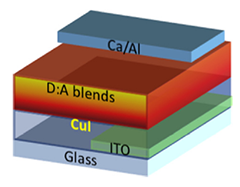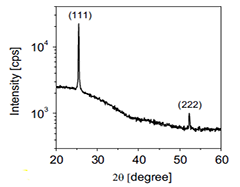X-RAY RUNS: Apply for Beamtime
2017 Nov 1 - Dec 21
2018 Feb 7 - Apr 3
2018 Proposal/BTR deadline: 12/1/17
2018 Apr 11 - Jun 4
2018 Proposal/BTR deadline: 2/1/18
Making commercially viable electronics out of organic materials is an ongoing challenge for chemists and materials scientists everywhere. One of the highest-stakes applications is the area of solar cells, where reliable operation depends upon developing stable and energetically suitable hole transporting buffer layers in tune with the electrode and photoactive materials of the solar cell stack.
For many years, the organic electronics community has relied on a conjugated polymer PEDOT:PSS (poly(3,4-ethylenedioxy-thiophene):poly(styrenesulfonate)) to block electrons and selectively transport holes to the anode of the solar cell. Unfortunately, PEDOT:PSS is acidic and can damage the transparent conducting electrode, the most common implementation of which is indium tin oxide (ITO). This publication from work at CHESS is the first to demonstrate that copper iodide is a good alternative to PEDOT:PSS that works well and is surprisingly robust despite being prepared in a wide range of conditions and temperatures [1].
The group of collaborators from the Materials Science and Engineering Division of Physical Sciences and Engineering at the Solar and Photovoltaic Engineering Research Center(SPERC) at the King Abdullah University of Science and Technology(KAUST, Saudi Arabia) worked with CHESS post-doctoral associate Ruipeng Li to show that copper iodide can be used to print solar cells with performance on par if not better than the best organic solar cells achievable using PEDOT:PSS. They expect this work can lead to an earlier market penetration of printed organic solar cells for a wide range of applications, including building integrated photovoltaics and wearable photovoltaics.
The work was led by Dr Kui Zhao, from KAUST, in collaboration with other KAUST scientists. Kui worked closely with Dr Ruipeng Li in order to determine the structure of CuI as well as the stacking order of the photoactive layer deposited on top of CuI. The group communicated that working with scientists at CHESS was instrumental in allowing them to achieve a rapid turnaround of the measurements and allow us to publish on a competitive timeline. In the weeks following our publication, several groups have reported on the use of CuI in various solar cell configurations, but we were the first group to demonstrate its use in state of the art organic solar cells.
CuI has been used in the past to template the packing orientation of vacuum-evaporated organic semiconductors by Guy Ngongang, a PhD student on the team. This study grow out of a discussion at a group meeting considering the possibility of exploring solution processing of CuI, which subsequently led to this project and a successful demonstration of CuI as a high performance interlayer for organic solar cells.


Left: Standard configuration of polymer: fullerene devices with CuI HTL at the bottom; right: X-ray diffraction (XRD) spectrum of the solution-processed CuI film (12 nm) showing (111) and (222) crystalline planes in γ-phase.
Reference:
[1] Kui Zhao, Guy O. Ngongang Ndjawa, Lethy Krishnan Jagadamma, Abdulrahman El Labban, Hanlin Hu, Qingxiao Wang, Ruipeng Li, Maged Abdelsamie, Pierre M. Beaujuge, Aram Amassian, “Highly efficient organic solar cells based on a robust room-temperature solution-processed copper iodide hole transporter,” Nano Energy, Volume 16, September 2015, Pages 458-469, ISSN 2211-2855, http://dx.doi.org/10.1016/j.nanoen.2015.07.018.
Submitted by:
Liyang Yu, KAUST, with Kathy Dedrick and Ernie Fontes, CHESS, Cornell University
10/12/2015
